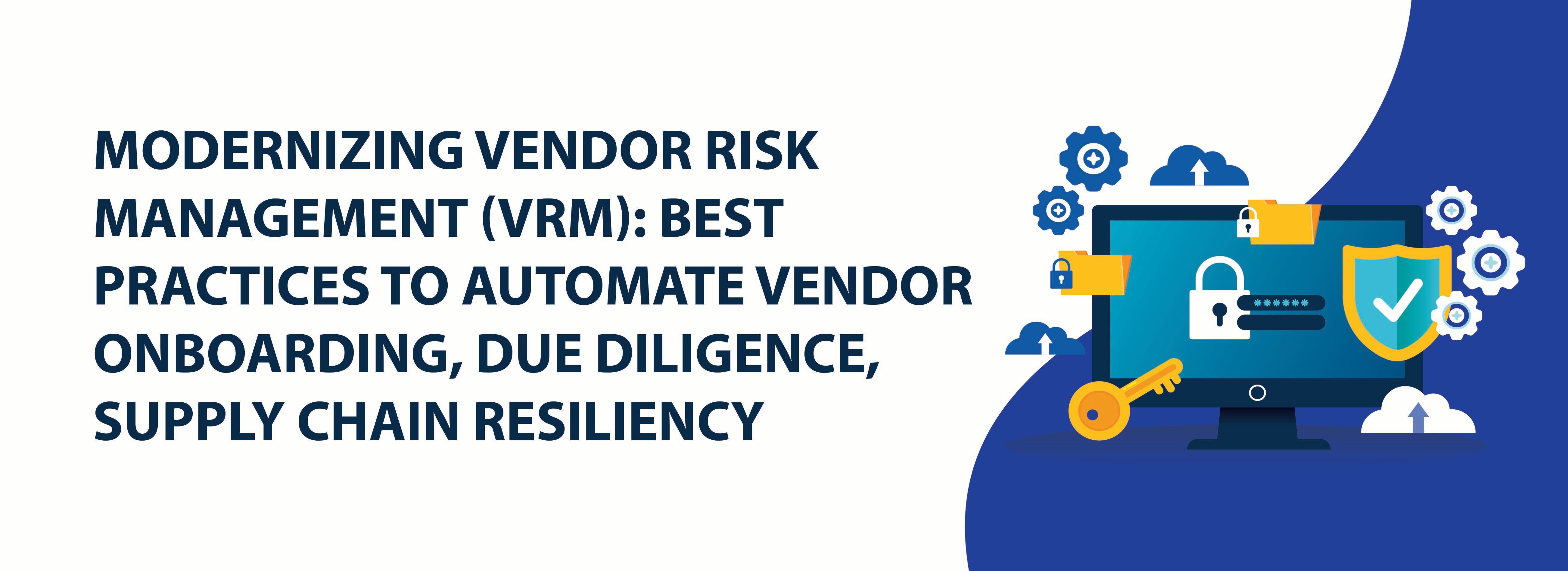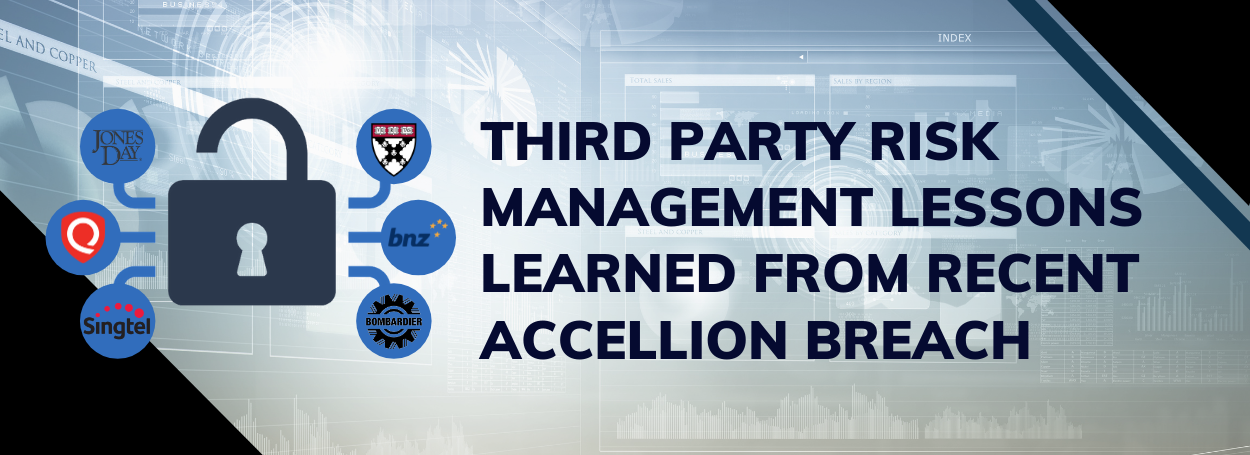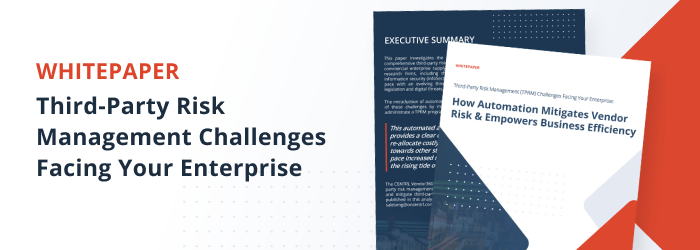Modernizing Vendor Risk Management (VRM): Best Practices to Automate Vendor Onboarding, Due Diligence, Supply Chain Resiliency

In today’s fast-paced world characterized by unrelenting competition, every organization exists in a vast network of risks. Some of these risks emanate from the organization as a business entity itself, while others introduce themselves when organizations come into contact with third-party vendors - and the latter are much harder to manage and contain.
Companies need the support of vendors to improve their bottom line and meet market demands. According to Gartner, as much as 60% of organizations today are working with over 1,000 third-party vendors. But the reliance on third-party vendors is an undertaking inherently mired in risks.
Companies must have proactive readiness to confront and manage vendor threats in all forms and magnitudes.
To successfully navigate the dilemma of forming new vendor relationships, and in consequence, opening yourself up to new risks, a modernized Vendor Risk Management (VRM) system has become indispensable.
Let’s have a look at the best practices to automate vendor onboarding, due diligence, and supply chain resiliency.
Pre-Contract Due Diligence
Vendor onboarding is the most critical phase in the VRM process. At this stage, the suitability of a vendor - the benefits and the risk they present to your business - are evaluated.
It goes without saying that exercising due diligence in this initial phase is imperative to ensure the third parties drive value for your business without exposing you to needless vulnerabilities.
For a thorough and effective risk assessment, the best practice generally followed by companies is the use of a systematic framework, commonly involving survey questionnaires.
That much is standard practice. But the real challenge begins when it’s time to assess and review questionnaires, which can quickly amount to thousands of questions, depending on the size of the survey and the number of vendors in your network.
Traditionally, organizations have relied on spreadsheets to prepare, collect, and review surveys for vendor risk audits, an exceedingly time-consuming and labor-intensive process. The good news is that you can automate this process by using VRM software.
VRM tools are equipped to automate the survey process. With an automated and streamlined survey process, you can multiply your capacity and perform vendor due diligence on a scale that simply isn’t possible with the manual and spreadsheet methods.
Any organization that wishes to implement systematic frameworks to vendor onboarding at scale must surpass the technological limitations that reliance on spreadsheets presents. This is the only way to modernize pre-contract due diligence and minimize exposure to third-party risks when onboarding new vendors.
Risk-Based Vendor Segmentation
No two vendors are ever the same. Neither in terms of the value they add to your business nor in terms of the risks they present. Ignoring each vendor’s unique attributes and criticalities by lumping everyone into the same category is the antithesis of due diligence.
Good risk management is all about isolating sources of risks, and segmentation helps organizations do exactly that.
To segment suppliers, organizations typically use criteria sets to evaluate each supplier’s importance to the firm and the risks they present.
Typically, vendors fall into three distinct categories by the nature of their relationship to a business: strategic vendors, core vendors, and transactional vendors.
Strategic vendors constitute only the smallest fraction of your network, but they are exceedingly important. The future strategy, technological advancement, and business growth of a company depend significantly on its relationships with strategic partners. This is why strategic vendors are one of the highest-risk vendors in your network.
Core vendors are essential to your daily operations. These are typically larger in number but represent a level of risk comparable to your strategic partners. Still, the loss of any core vendor wouldn’t cause havoc to your operations since they are easier to replace.
The third and final category of vendors is transactional suppliers. The extent of the relationship with such vendors is confined to the supply of materials and commodities. As a result, these suppliers constitute your vendor network’s most considerable fraction and are the easiest to replace.
The ability to segment vendors based on risk is, therefore, exceedingly important. But many organizations rely on obsolete and outdated practices like the use of MS Excel for vendor categorization and risk assessment. Remember that these tools have capacity limitations, high error rates and simply not been built for vendor risk management.
The best thing about the modern VRM tools is that they allow you to automate vendor segmentation, risk profile building, and risk assessments. These dedicated tools are powered by rich features, allowing for better evaluation of the different players in your network.
Wide Angle Visibility of Vendors
According to a BeyondTrust survey, 58% of the organizations reported experiencing a vendor-related security breach in 2019. That underscores the fact that every supply chain and network of vendors have blind spots that only a comprehensive, 360 visibility can eliminate.
In the traditional, spreadsheet-based assessment frameworks, obtaining the vantage point of all-encompassing visibility is outstandingly time-consuming.
An automated VRM tool makes the entire process significantly efficient by aggregating all vendor-related data in a single centralized space. This naturally results in a comprehensive view of all vendors in your network, facilitating an improved understanding of vendor relationships and strengthening supply chain resilience.
Visibility is a precursor to effective risk management, so companies must do away with legacy systems obstructing comprehensive visibility of outsourced relationships.
Standardization and Data Consistency
As stated earlier in this article, 60% of organizations today are associated with vendors in one way or another. Naturally, the volume of data generated by these vendors is immense. When firms rely solely on spreadsheets, inconsistencies are bound to occur, especially when many users access the same resources.
Inconsistent data doesn’t lend itself to easy analysis. Consequently, the whole risk assessment process becomes more convoluted and time-consuming than any firm would ideally like.
Automated VRM systems iron out these inconsistencies and enable the use of standard processes throughout your vendor chain. With a centralized database containing all the vendor documentation, each using the same data formats, it becomes much easier for internal departments to review and monitor the risks posed by each vendor.
Vendor360 - A Software Designed to Modernize Your VRM Processes
Vendor360 is a next-gen, centralized VRM platform that automates and streamlines vendor onboarding, due diligence, supply chain resilience, and more. This powerful and dedicated VRM software contains pre-built survey questionnaires. It provides automated functionalities for aggregating questionnaire responses in a centralized database, along with scores of other valuable VRM features.
Deploy Vendor360 today and automate the many different aspects of your VRM process.
Learn more about Vendor360 or experience this state-of-the-art solution with a LIVE Demo.


